As Christmas Day fast approaches, many people are starting to plan for their Christmas feast. Will it be a juicy ham, festive turkey, hearty roast beef, or perhaps some fresh seafood?
No matter what your Christmas traditions are, food poisoning doesn’t discriminate. Good food safety practices must be followed before, during and after your Christmas meal to help keep you and your family healthy. Below are some quick tips for preparing and consuming your favourite Christmas proteins.
Pork
Storage
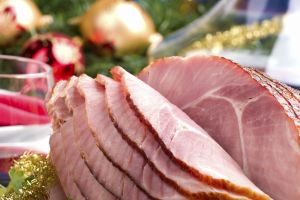 Nothing says Christmas quite like a traditional ham. Most hams sold by your local butcher are pre-cooked and will keep for several weeks with proper handling. To keep your ham fresh, remove it from its plastic wrap and wrap it loosely in a clean tea towel or pillowcase that has been rinsed in 1 litre of water and 2 tablespoons of white vinegar, wrung out tightly. Store your ham in the fridge below 5°C, changing the tea towel every day.
Nothing says Christmas quite like a traditional ham. Most hams sold by your local butcher are pre-cooked and will keep for several weeks with proper handling. To keep your ham fresh, remove it from its plastic wrap and wrap it loosely in a clean tea towel or pillowcase that has been rinsed in 1 litre of water and 2 tablespoons of white vinegar, wrung out tightly. Store your ham in the fridge below 5°C, changing the tea towel every day.
If a good pork chop or roast is more your thing, these are sold raw and can be purchased several days prior to consumption. Store raw meat products at the bottom of your fridge to prevent any juices leaking onto other foods.
Cooking
Pork products can be cooked fully or have a little pink tenderness to them (except mince and sausages). Use a food thermometer to check that the thickest part of the meat is 75°C or more in the centre before serving.
Leftovers
Bacteria thrive in temperatures between 5°C and 60°C (i.e. when food is sitting out on the dinner table after a meal). Refrigerate any leftovers as soon as possible. Pork should be tightly wrapped to prevent the meat from drying out when exposed to air. Leftovers should be consumed within 4-5 days or can be frozen for up to 3 months.
Poultry
Storage
Turkey is a well-loved Christmas tradition, but can be a challenge to cook as it’s not something we eat very often. Turkeys are sold raw and often frozen, so before you start cooking, it’s important to ensure your turkey is completely defrosted in the centre. Keep your turkey out of the temperature danger zone (5°C – 60°C) by defrosting it in the fridge. Depending on its size, this may take a few days, so plan ahead.
All raw poultry meat (e.g. turkey, chicken, duck, goose, etc.) should be stored on the bottom shelf of your fridge to prevent any juices potentially contaminating ready-to-eat foods.
Cooking
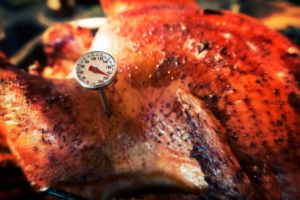 Beware of cross-contamination between raw poultry and other food in your kitchen. Wash your hands thoroughly after touching raw poultry and use a separate cutting board and kitchen utensils to prep your bird. Do not wash raw turkey or chicken – this can spread harmful bacteria around your kitchen. Instead, wash anything that has come into contact with raw poultry with hot soapy water before prepping anything else.
Beware of cross-contamination between raw poultry and other food in your kitchen. Wash your hands thoroughly after touching raw poultry and use a separate cutting board and kitchen utensils to prep your bird. Do not wash raw turkey or chicken – this can spread harmful bacteria around your kitchen. Instead, wash anything that has come into contact with raw poultry with hot soapy water before prepping anything else.
Turkey stuffing can be cooked separately in a casserole dish to ensure it’s thoroughly cooked. If you prefer to stuff your turkey, put the stuffing in just before cooking, try not to overstuff the cavity, and remember that stuffing can slow down the cooking process.
Poultry meat should always be cooked thoroughly (no pink meat or blood). Use a meat thermometer to check that the temperature of the thickest part of the bird reaches 75°C and the juices run clear. Ensure the centre of your stuffing has also reached this temperature.
Leftovers
The best part of a roast turkey are the leftover sandwiches! That’s why is important to refrigerate your leftovers quickly, to keep meat out of the temperature danger zone (5°C – 60°C). Slice any remaining meat off the carcase and store in smaller containers to ensure the meat cools quickly. Consume any leftovers within 3 to 4 days.
Red Meat
Storage
Maybe a roast beef or lamb chops are more your style at Christmas? Australia produces some of the best red meat in the world, and Christmas is the perfect time to indulge. Fresh red meat can be purchased 3-5 days ahead of time and refrigerated in its original packaging. Store raw meat at the bottom of your fridge to prevent any juices dripping onto other food.
Cooking
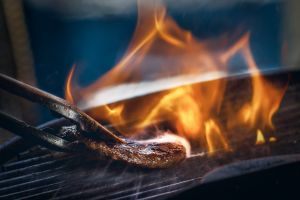 Remember to wash and dry your hands thoroughly before and after touching raw meat and prevent cross-contamination between raw meat juices and ready-to-eat foods during food prep.
Remember to wash and dry your hands thoroughly before and after touching raw meat and prevent cross-contamination between raw meat juices and ready-to-eat foods during food prep.
Rolled or stuffed meats, sausages and mince dishes (e.g. hamburger patties) should be fully cooked to 75°C. All other steaks, chops and solid pieces of red meat can be cooked to your liking.
Leftovers
Transfer leftovers into a shallow container and refrigerate as soon as possible, once the steam stops rising. Leftovers should be consumed within 3-4 days, or frozen for up to 3 months. Remember to defrost meat completely before cooking it otherwise it may not cook fully.
Seafood
Storage
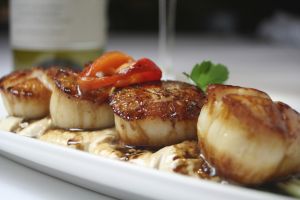 Hot summer days make seafood a popular choice for many Queenslanders at Christmas. But remember, seafood spoils quicker than meat and should therefore only be purchased 1-2 days in advance, and at the end of your grocery trip just before you head home.
Hot summer days make seafood a popular choice for many Queenslanders at Christmas. But remember, seafood spoils quicker than meat and should therefore only be purchased 1-2 days in advance, and at the end of your grocery trip just before you head home.
Ask your seafood retailer to pack your seafood with ice, transport it home in a zipped cooler bag and then promptly place in the coldest part of your fridge. Don’t leave seafood in the temperature danger zone (5°C – 60°C) for any longer than necessary.
Cooking
Seafood should be cooked thoroughly, except oysters which can be served raw.
Prawns
You can purchase prawns either pre-cooked or raw. Raw prawns will need to be cooked all the way through. Pre-cooked prawns can be served cold. Whichever your preference, it’s best to keep a prawn’s shell on until just before you prepare them as they will preserve better.
Oysters
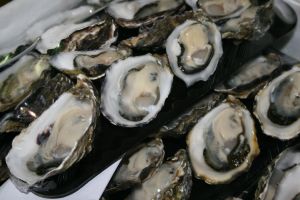
Oysters can be served steamed, stewed, sautéed, baked, broiled or raw. If you are opting for raw oysters, inspect the shell and discard any oysters with shell damage. The shell should be glossy white in colour on the inside, although a few pink or grey streaks is acceptable.
If you are buying opened oysters, inspect the oyster meat. Healthy oysters are plump, with a glossy tan colour. Bad oysters are dry and withered with a cloudy appearance. If you can, smell the oyster meat. Healthy oysters smell fresh and mild, like the ocean breeze. Bad oysters have a strong pungent fishy smell.
For optimal freshness, oysters should only be purchased 1 day before consumption, though can last in your fridge for up to 5 days. To increase shelf life, cover them with a clean damp cloth, and store them flat side up.
Leftovers
Cooked fish and other seafood can be safely stored in the refrigerator 2-3 days or frozen for up to 3 months. Prawns can last in the freezer between 6-8 months if stored below -18°C.
Oysters
If you plan on freezing oysters, you must first shuck them. They can then be frozen in regular freezer bags. Defrosting them and eating them raw is not recommended, you will need to cook them.
Food poisoning
 We hope these food safety tips are helpful in planning your Christmas meal.
We hope these food safety tips are helpful in planning your Christmas meal.
If you suspect that you may have become ill from food, you should:
- consult a doctor
- refrigerate any remaining food for testing and keep the packaging if possible
- advise the food business of the illness, including the type of food eaten, so they can deal with any remaining suspected food
- report the issue to 13 HEALTH (13 43 25 84), particularly if another person has similar symptoms after eating the same food.
For more information about food poisoning, please visit the Queensland Health website.
From all of us at Safe Food, have a happy and healthy Christmas.
